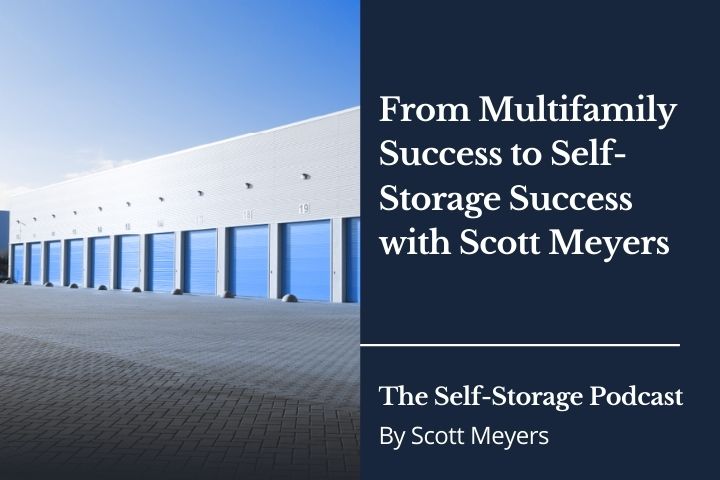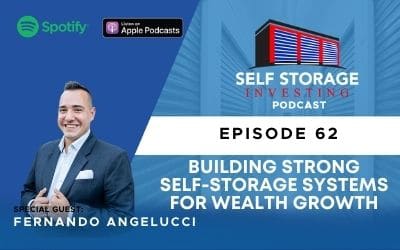Travis Baucom was rocking it. He’d grown a fund to over 400 homes but suddenly realized he needed to pivot. That’s when he made the move into self-storage and has never looked back.
In this episode Travis shares some of his strategies, particularly in an uncertain market.
WHAT TO LISTEN FOR
The approach Travis takes to managing sellers’ expectations
A key strategy for acquisitions and developments in the forward market
Travis’ marketing approach working with brokers closely and forming a relationship
The need for creativity and tighter evaluation when there is market uncertainty
ABOUT TRAVIS BAUCOM
Travis is the CEO of Balcomie Capital, a boutique firm for high-net-worth and high-income individuals. Having started his journey in private markets in 2012, Travis has successfully been involved with over $5 million in AUM through acquisition, development, repositioning, disposition, asset management, and strategic planning.
CONNECT WITH TRAVIS BAUCOM
Web site http://www.investinstoragedeals.com/
Email: travis@balcomiecapital.com
Phone: (254) 292-3376 (Text)
Instagram: https://www.instagram.com/travis_baucom/
Facebook: https://www.facebook.com/people/Travis-Baucom/8359225/
Twitter: https://twitter.com/TravisBaucom?s=20
LinkedIn: https://www.linkedin.com/in/travisbaucom/
CONNECT WITH US
Website: https://www.selfstorageinvesting.com/
Facebook: https://www.facebook.com/selfstorageinvesting
Twitter: https://twitter.com/SelfStorageGuy
LinkedIn: https://www.linkedin.com/in/scottameyers/
Youtube: https://www.youtube.com/user/SelfStorageInvesting
Instagram: https://www.instagram.com/self_storage_investing/
Follow so you never miss a NEW episode! Leave us an honest rating and review on Apple Podcast.
Episode Transcript
Travis Baucom (00:00):
I would say we look at a lot more deals than we put offers in as opposed to like we were putting offers in pretty much anything back in 2022. But right now we’re just, I think we’ve made, I think this month we’ve made two offers on facilities and those of course got rejected because they’re not full price, they’re not, maybe they even in include some seller financing. We’re trying to get as creative as possible.
Self-Storage (00:31):
This is the Self-storage podcast where we share the knowledge and skills from the industry’s leading investors, developers, and operators to help you launch and grow your self-storage business. Your host, Scott Meyers, over the past 18 years has acquired, developed, converted and syndicated nearly 5 million square feet of self-storage nationwide with the help of his incredible team at selfstorageinvesting.com, who has helped thousands of people achieve greatness in self-storage.
Scott Meyers (01:06):
Hello everyone and welcome back to the Self-Storage Podcast. Hi, I am your host Scott Meyers and this week’s guest is Mr. Travis Baucom. Now Travis and I have known each other for a number of years and his path has been very similar to mine. In that time, he had a company that was very active in single family homes moving into other asset classes, and he too found self-storage, saw the light, and recognized that building a portfolio of self-storage facilities as his real estate portfolio was much better than managing the tenants and toilets and trash that he was currently in. And so he is, in five years, he grew a fund to over 400 homes and that it was at that time that he recognized that it was time to make a pivot and a shift into self-storage. And that’s where he and I met.
(01:53):
And since then, he is now very active in all things at self-storage, both a acquisitions as well as developments. And so we spend time in this episode of talking about his transition into self-storage, the reasons why the it does so well during a recession. We talk a little bit about how he manages sellers expectations in a market in which they still feel as if they can get the prices that they were receiving back in 2021. And then also how is he, he is approaching this market going forward with his developments as well as acquisitions and his specific strategy for attacking this market right now. So with that, please enjoy my wide raging conversation with myself and Mr. Travis. Welcome.
Travis Baucom (02:36):
Thanks for having me, Scott.
Scott Meyers (02:38):
Well, I’ve given everybody a little bit of background on yourself and somewhat as to what you’ve been doing in the self-storage space and this syndication space. But if you would, why don’t you give us a little more background, fill in the gaps and tell us what you’re up to right now and how you’re approaching this market that we’re finding yourselves in.
Travis Baucom (02:54):
Yeah, it’s carefully would be the quickest answer for that. But yeah, we’re going after more of the higher cap rate stuff, stuff that we find in the rural markets, tertiary markets. Historically, we were residential buyers and we made a switch about three years ago into self-storage and it was a very hot time three years ago to get into self-storage. And we say that’s cool enough a little bit. There’s not as many offers on the table for the facilities that we’re going after. So we’re adjusting and trying to make sure that when we buy, we’re buying positive cash flowing properties on day one.
Scott Meyers (03:31):
Well, obviously everybody’s looking for high yield and that the value add up projects and things that are cash flowing out of the gate. Talk a little bit about marketing and maybe some of the techniques and the strategies that you’re having to use now to go the extra mile to fill the funnel. It, it’s not as easy as it used to be and there certainly isn’t the low hanging fruit out there that we’ve seen in the years past.
Travis Baucom (03:52):
Compared to a lot of companies out there. We’re pretty small. We’re still working with brokers primarily and cold calling the facilities that we see when we’re driving to and for back and forth from wherever we’re going. Typically we just want to take out brokers, have lunch with them, tell ’em what we’re looking for, but also really become their friends, not just some other guy to send deals to, but we want to be that person or that group that when they have a baby or something like that, we’re sending them a gift, we’re sending them a congratulations message, something like that. And that’s helped us get a little bit more information than I would say typical self-storage buyers we get. So that’s helped a little bit.
Scott Meyers (04:40):
I would say so. Well, filling your funnel with opportunities is a shotgun approach, and that is sending mailers out and talking with and creating relationships with the owners of the themselves so that when it is time for them to sell, at least we hope that they will be contacting us because we’ve built up that relationship. But many people have neglected that building that relationship with the brokers as well. We look at ’em more as a resource and sometimes competing against them in the marketplace. They’re sending mailers out to the owners of the facilities trying to create that relationship, stating the reasons why they should list with them because they’ll get ’em the most. And we’re creating relationships with those sellers also competing, saying, Hey, we’ll give you the more, most money and you don’t have to pay those brokers commissions, but we realize you should realize that the brokerage community is absolutely essential to your team.
(05:31):
And if you do a deeper dive and create those relationships with them, not everybody is going to sell to an individual that got a postcard or a letter or a phone call from you. They don’t have time. They will only go through brokers and that’s why they hire them is so that they don’t have to vet many of the folks that don’t have the ability to transact or just to make sure that they march through the process correctly because they don’t want to do this on their own. But I think many investors have seen and they really neglect that piece and they haven’t taken that deep dive that you have as well. And so what does that look like on a regular basis in the markets that you’re operating in, Travis, how many brokers would you say that you have a good relationship with it? Are funnel projects your way in maybe giving you some of those pocket listings or first crack?
Travis Baucom (06:17):
Sure, sure. We primarily just buy in Texas right now, and so we have brokers that are my age. Those are the ones that I want to create the best relationships with because I know in 30 years they’re still going to be sending me deals. And so we have, I would say three or four brokers that we really are really close to. And then we have about a half a dozen others that know our names. Thankfully we’ve done a good job at presenting my marketing, my name, marketing my company out on the internet, so when they get an email from me, they actually take it serious as opposed to just kind of like, oh, this is one of those looky-loos, as you said, or someone who’s not really that serious in participating in bringing an offer.
Scott Meyers (07:05):
So Travis, you’ve moved into self-storage, you’ve been in other asset classes. Are you still investing in other asset classes? Are you 100% focused on self-storage at this time?
Travis Baucom (07:17):
Yeah, we’re not buying anything new in other as asset classes. We have a few, couple funds that we’re trying to wind down. The residential side has been really helpful. However, building materials, interest rates, that’s really kind of stymied a lot of our efforts. However, a lot of those will be done in probably 12 to 18 months. And then at that point, we’re just planning on buying storage. It’s done really well. We’ve got seven facilities right now. They are substantially easier to operate than trying to figure out where the plumber is and where the framer is and why he didn’t show up and dealing with city issues, that sort of thing. So we really enjoy the simplicity of self-storage way more than dealing with the headaches of residential.
Scott Meyers (08:02):
OK Well, so Travis, we’ve got folks here in the storage nation that listen to this podcast that are there in all different stages of their investing career in self-storage. Some are still on the outside looking in, others are growing and scaling. Others own a handful of facilities, maybe seven like yourself that are kind of staying put or at least maybe wait until the dust is settling with interest rates and to see where the market is going and where is the bottom or when are the true deals going to be coming out. How are you approaching this market in terms of speed? Are you gathering everything that you can right now? Are you super bullish on self-storage? Are you being cautious in what you’re looking at or do you have some gunpowder that you’re leaving behind for fourth quarter of this year or heading into the next year? What is the speed that you’re approaching this market right now?
Travis Baucom (08:48):
Yeah, we, we’ve slowed down quite a bit and it’s primarily because our limited partners have their cash have kind of dried up. We’re still looking for more limited partners, more passive investors for our deals. But the kind of pool that we had from the residential space, those people have either put their money in deals that we had or they lost it in the market or lost it in crypto or lost it in another deal, or maybe it’s stuck in another deal because they can’t get it refinanced. And so we’ve slowed down quite a bit. I would say we look at a lot more deals than we put offers in as opposed to we were putting offers in pretty much anything back in 2022. But right now I think we’ve, this month we’ve made two offers on facilities and those have of course got rejected because they’re not full price, they’re, maybe they even include some seller financing.
(09:36):
We’re trying to get as creative as possible, primarily to lower the risk on our side because we don’t know if last three years we’ve been able to raise rents 20, 25% per facility. We don’t know if we’re going to be able to do that anymore. So we’re really coming into it with kind of a model of if it doesn’t improve right now, how do we make this work for us? And that’s allowed us to, or to slow down quite a bit. Thankfully we do have do have some powder and some dry powder to stave off needing to buy something. We’re not in a place where we have to actually buy something to make it work. So if we do get something under contract, we know it’s a home run.
Scott Meyers (10:16):
Good, good. That’s always the best way to approach the market when you don’t have to buy something to feed either some investors or Wall Street or anybody else for that matter. So you know, touched on, you just mentioned in passing. So we made two offers and of course they got rejected because they were full price offers. And so that speaks to the market and where we’re at right now. And that is educating the seller or managing the seller’s expectations. And as we talked earlier about brokers, that is a broker’s job in many cases, especially right now as to manage the seller’s expectations. They saw what their buddies did or maybe even a facility that they may have sold out of their portfolio a year ago or a year and a half ago. And there were 20 different offers that had sold for 7% above list, but we’re in a different market right now.
(11:02):
The sellers are still looking for and expecting that. However, interest rates have now forced a slowdown and for us to get back to underwriting that makes the most sense. And then educating or conveying that to our sellers as well. And in some instances we put our underwriting right across the desk in front of ’em, we take it back of course, but ’em see and ask ’em the question, Hey, would you buy your facility at this price right now if this is your cost of capital? And of course we know the answer to that, but those are the simple means by which we get sellers to align themselves and their expectations with the market. But what are some of the other ways, Travis, that you use to be able to work with sellers to say, listen, if you want to sell right now, you’re going to have to come here. And it’s not me, it’s the bank, it’s the appraiser. Are some of the tactics and strategies that you’re using to get these folks out of the sellers to maybe come off their number and be a little more realistic to transact a deal?
Travis Baucom (12:02):
Yeah, a good question. I would say there’s going to come a time where sellers realize it’s not 2021 anymore. And I’m starting to see some trickling in the market where they’re being a little bit more rational, being a little bit more realistic. But we basically do the same thing. We will say, Hey, this is where we’re at, this is what you want, but for us to make money, we have to be right here. We’re just not going to be right there. If you find someone else that wants to buy for that, that’s totally fine, but this is where our offer is and this thing is solid. We’re 100% going to close on this unless something massively outrageous happens, we’re going to close on it. And so I would say that it goes back to the communication standpoint of just really communicating, this is where we’re at and this is where you want to be, but no one else has come here and we’re here so you got to make a decision. Do you want to keep this thing or do you want to sell it to us?
Scott Meyers (12:57):
Yeah, and I think at the end of the day, that’s really the only options, which is, Hey, do you want to sell right now? And if so, this is where the market is. It’s not me saying this is where the lender’s going to end up and this is where the appraiser’s going to end up. Or we take our buyer’s hat off and put our consultants’ hat on and say, if you want to sell it for this price, then here’s some of the things you need to do. And then maybe we’ll revisit this in six months and is it okay if I follow up with you and work with them to get the number that they need? Which is more than most buyers will do, and hopefully they will come back to us at that point. But that isn’t always the case. So value add is the name of the game and it’s the name of the game that you’re in as well. What are some of the ways that you’re finding right now, Travis? Are you having to get more creative in terms of the value add to get to a certain exit number or is it just the tried true expansion raising rates? As you mentioned, we can’t raise rates like we did before. What are some of the ways that you’re finding that you have to stretch a little bit to increase the value of these facilities that maybe you haven’t had to or been able to do before?
Travis Baucom (14:03):
Yeah, we, we’ve found a lot of luck with or a lot of benefit in using the modular units. So you know, might have a section that you can’t develop because it’s too small, but you can put three or four modular units and it makes sense there. So a 10 by 22, 10 by tens, you know, can get those shipped within about three weeks. So within three weeks you can increase your revenue. We just have a facility right now, it’s real small. It was like 7,000 square feet on two acres and the city was kind of giving us grief about developing the extra through a traditional process. So we just added another 6,000 square feet within three weeks and those are already on our website to lease out. And they cost a little bit more than traditional traditional, but traditional construction will take six months, whereas I can drop these suckers, they’re not considered real estate, so the city can’t tax ’em, not considered real estate. So the city can’t tell me I need to get a permit for ’em. And so we just, we typically do gravel around them and that’s probably one of the most exciting things I’ve done lately as far as adding value to a facility.
Scott Meyers (15:16):
It really is, it’s a beautiful thing for all the reasons that you just mentioned that they’re readily available, you can drop ’em in, no permits, personal taxes versus property taxes on the assessment side. And really the only downside that we’ve seen is, as you mentioned, they’re a little bit more expensive, but every once in a while we’ll run into a lender either on the exit or a refinance and which the, they’ll state that, well, we can’t include all that income or we’re not going to include any of that income because it is movable and the income stream could move. That’s pretty rare case. And a lot of the funding that we do and many of the folks that are on this podcast are doing is through the SBA and they recognize this all day long. But that has really been about the only downside that we’ve seen or perhaps maybe a buyer that may have an issue with the fact that we’ve got a significant amount of those.
(16:06):
On the flip side, we’ve looked at facilities that are built and developed 100% with movable units and we’re in the process of developing one here in Indianapolis. So it’s be 100% movable storage units somewhat by necessity, but then also once we get into it, then really by choice it’s going to make a lot of sense. And so we’re getting close to getting off the ground with that project here very soon. So operationally, Travis, you’ve got to the place where you got seven facilities, they’re all in Texas. Are you self-managing right now? Are you doing a combination of working well with a third party or how do you maximize that, the NOI on your seven facilities right now?
Travis Baucom (16:49):
We have one in a really small town in Texas. We actually have a lady that sits in the office still. Outside of that we do remote management. We’re really satisfied with our, we had to bounce around to figure out which remote manager is going to work, but we’re really satisfied with the one that we have now. They really take a good strong, it’s almost like they’re part owners like that. That’s a really good manager there when they’re concerned about the facility more than you at times. One of the best things I appreciate about our remote manager, the first one they had overseas answering VAs and it was pretty brutal. Some of these rural towns in Texas, you just don’t, those people, the tenants don’t want to talk to someone who sounds like they’re Chinese or whatever for various political reasons. And the one we’re using now, we’re actually using real good people are typically like single moms, older ladies based in a small town of Texas.
(17:48):
They’re all, each one of ’em is a manager of each one or two facilities, remote manager of one two facilities. So every time the phone ring, phone rings, it goes to Patty or Sandy as opposed to someone, someone who speaks English as a second language. While we’ve realized that is absolutely a game changer when it comes to leasing up units. So we really like that. And then we have a fractional, a fractional facilities owner that shows up once a week, puts over locks, mows the yard, takes over, locks off if there’s a gate problem, they can show up and picks the gate. There’s light problem or security camera. They can show up outside of that time. And I think that’s a pretty good gig for someone who just works once a week and I know how much we pay them, it seems for as little as they do, they make pretty good money for it. Yeah,
Scott Meyers (18:40):
We’ve always found there, there’s always at least a person in any market that we’ve been able to hire that drives a truck and understands self storage that can do all those things that you just mentioned and has enough tools that they know how to handle locks, they know how to handle the gate software as well as the mechanicals and also replacing springs and just they bop around to our facilities and as wider range as that we can send them. And we’ve never had a problem being able to handle that without having to take in that person in-house, if you will. So let’s talk a little bit about marketing. We are also heading into a time right now where leasing activity does sometimes is reduced where people may not be apt to just throw everything into self storage. We also see the activity level in terms of people moving house, depending upon what part of the country you’re in. Some of the house sales have slowed a little bit and that is a big driver for self-storage. How have you had to change or what have you done to change your marketing strategy and perhaps even some of your advertising tactics?
Travis Baucom (19:47):
So for that one small facility that we have, or it’s pretty large facility, we have in a small town, we actually do P P C didn’t work Google our business kind of worked a little bit, but generally, but we’re in the newspaper on that facility. We’re in behind, we’re in the outfield of the little league park on that. And so things that typically don’t work anymore, that’s what we’re using in that market because we’re just, when PC didn’t work, we’re like, well, we got to get creative on this. And then on the other two facilities, the bigger ones kind of in major markets, those we just PVCs working Google my business is working, we’re really making sure that we get as many reviews from tenants as possible. So we’ll get $10 off if you leave a review or sometimes we’ll even make that $20 cash if you leave a review, you want to be…
(20:38):
The way Google my business works is the more positive reviews you have, the higher you are going to be there. So if you’re competing at 16 different facilities, you don’t want to be the bottom a bunch of five crappy reviews. You want to be the 48 50 sort review person. And so that’s our goal is to really optimize that. But generally speaking, drive by having a huge sign, having a bright colored sign. We buy facilities, we want to buy ’em on major thoroughfares. So there’s a lot of drive by traffic high V P D per day.
Scott Meyers (21:13):
Well, at the end of the day it really is, it’s basic blocking and tackling. This is a commodity, it’s a needs basis. So when people need storage, we just need to be in front of public. We can always create demand for storage. Every once in a while we’ll see that the REITs, the big guys will run some ads in the spring when they know that people are looking to either move or clean out. But by and large, we just need to make sure that we are in front of ’em and that there is that awareness. So Travis, as we wrap up, once again, appreciate your time and to be able to speak a little more into your business a little bit more about what you’re doing. But where are you heading, say the rest of this year and what is the ultimate goal in self storage and say the next five to seven years?
Travis Baucom (21:59):
Yeah, like I said, we shifted here pretty recently. We had a big facility we were going to develop in Austin, Texas. We ended up selling that as a entitlement to another developer to actually a pretty large brand name. And then we have one in South DFW in the town called Ennis that we will be building. We will be building, I’m partnering with the landowner on that and he’s providing on the capital so I don’t have to raise capital. It makes it pretty easy. Still looking to buy another one or two facilities this year, if not three facilities. And then we’re just doing a big effort on really raising awareness of what we’re doing to accredited investors so that they can participate in our endeavors here.
Scott Meyers (22:43):
So it sounds like more of the same, looking at the opportunities that are out there in the marketplace. Also a development when development makes sense to do so. And then yeah, doubling down in the market that you’re in sounds like a good plan. Well, there is no better time to be investing in self storage right now that we feel, and I’ve been stating this for the past 18 years because this will be our third recession that we’re heading into. And regardless of what the market is doing, whether we are in a high inflationary mode, interest rates are going up, is an incredible time to be buying. And when interest rates are low and money is flowing, we are also buying as well as selling, which we know the cap rates are low, and that is the best time to be repositioning our assets as well. And so Gang Storage Nation out there, this has been a brief case study with Travis here as to how he’s approaching the market, how active he is right now, and what he’s been doing and pivoting into the marketplace as well. So Travis, if people want to learn a little bit more about what you’re doing, maybe invest alongside of you or take a peek into your business, one of the best ways that they can reach out to you.
Travis Baucom (23:49):
Yeah, the best way would be to go to invest in storage deals.com and you can scroll to the bottom and fill up short form and you’ll be added to our list.
Scott Meyers (23:59):
Beautiful. Beautiful. Well, Travis, as we wrap up here, if you would share what is one of the best pieces of advice that anyone has ever given you,
Travis Baucom (24:11):
Don’t quit.
Scott Meyers (24:14):
Yeah, enough said perseverance is the name of the game in any small business, and it certainly isn’t in real estate, so appreciate that. Well, Travis, thanks so much for your time, appreciate you and looking forward to round two. Looking forward to hearing more about your acquisition strategy, your developments. And yeah, so appreciate your time again today, Travis, and looking forward to round two in the future. And we’ll check back in with you. So Storage Nation, you’ve been meeting with myself and Travis here, so looking forward to meeting with you all again. So check back in for another incredible episode of the Self Storage Investing podcast. Take care.
Self Storage (24:56):
Hey gang, wait three things before you leave. First, don’t forget to follow the Self Storage podcast and turn on your notifications so you never miss another episode. And while you’re there, please leave us a five star review if you like the show. Second, be sure to share your favorite episodes and more via Instagram, and don’t forget to tag us. And lastly, head to the links in the show description and hit follow on Twitter and Facebook to get a front row seat as we grow and scale our business and bring you along with us.















